Dog Agility Tunnels for Large Breeds: A Detailed Guide
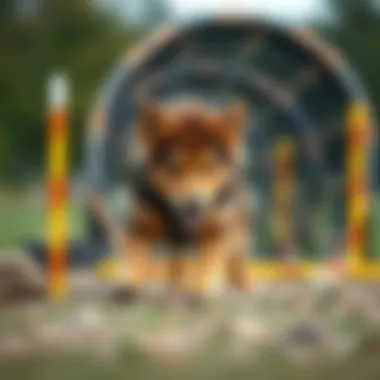
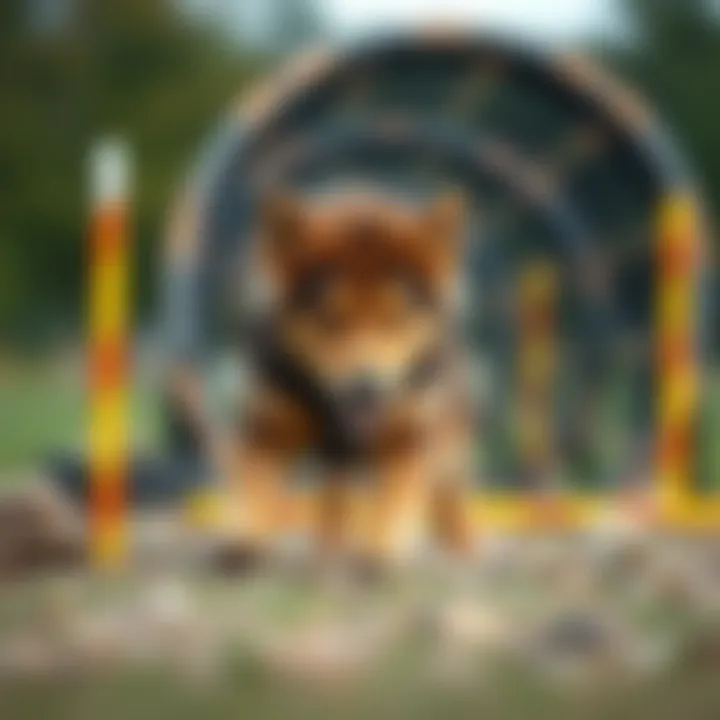
Intro
In the bustling world of dog agility, one piece of equipment stands out for its sheer excitement and versatility: the agility tunnel. These tunnels, particularly designed for large dogs, offer much more than just a fun activity. They provide an avenue for exercising and enriching the lives of our furry friends, keeping them both physically and mentally active.
Agility tunnels come in various forms, constructed using materials that can withstand the spirited antics of larger breeds. The many colors and shapes available entice dogs to navigate through them, turning a simple walk into a thrilling experience. However, the benefits extend beyond just entertainment; proper use of agility tunnels can enhance a dog's coordination, confidence, and overall fitness.
As we journey through this guide, we will unravel the essentials of selecting, using, and maintaining these tunnels. We will explore the specific needs of large dogs and delve into the training techniques that can help your canine companion master this uniquely stimulating obstacle. Along the way, we will highlight safety considerations, grooming tips, and essential health checks that ensure a seamless agility experience.
Ultimately, our goal is to equip dog owners with the knowledge they need to foster a nurturing environment that caters to the unique needs of their large breed companions while enhancing the bond between human and dog.
Foreword to Dog Agility Tunnels
In the realm of canine activities, dog agility tunnels represent a bridge between physical exertion and mental engagement for our larger furry companions. These unique structures not only provide an outlet for energy but also present an opportunity for bonding between owner and dog, enhancing the overall training experience. Whether you’re upgrading your home training setup or participating in competitive agility events, understanding what agility tunnels entail is crucial.
Definition and Purpose
Agility tunnels are specially designed for dogs to navigate through as part of agility training. The primary purpose of these tunnels is to develop a dog’s speed, coordination, and focus while providing a fun and stimulating environment. Unlike traditional playtime, which may lack structure, agility tunnels offer a definitive task that encourages dogs to think and act quickly.
They are usually made from flexible fabric or hard plastic, optimized for safety. In essence, these tunnels are not just equipment; they’re tools fostering connection, communication, and a shared sense of achievement between a dog and its handler. When a dog successfully maneuvers through the tunnel, the sense of accomplishment can be palpable.
Popularity Among Training Enthusiasts
The surge in popularity of agility tunnels among training enthusiasts can be attributed to several factors. Firstly, the increasing awareness of the importance of physical and mental stimulation for dogs has heightened interest in various forms of training methods, particularly agility training.
Many trainers and dog owners have found that agility courses, including tunnels, create a dynamic environment that challenges dogs to push their limits while also maintaining focus. Additionally, with the rise of social media, showcasing agility feats has become a rewarding experience for both dogs and owners alike, adding to the appeal.
Moreover, communities have begun to organize competitions, fostering a sense of camaraderie among participants. In fact, many dog owners report that engaging in agility activities helps reinforce obedience and responsiveness, underscoring why more tail-wagging enthusiasts are flocking to agility tunnels.
"Training is not just about commands; it’s about shared adventures that strengthen the bond with your canine friend."
In summary, understanding agility tunnels provides a foundation upon which dog owners can build richer, more engaging experiences for their pets. As we delve deeper into the specifics of these tunnels, the benefits they offer, and the nuances of selecting the right one for your large breed, it becomes evident these tools are more than mere accessories; they’re gateways to improved well-being for both dogs and their humans.
Benefits of Using Agility Tunnels
Agility tunnels are more than just a flashy addition to a dog park; they serve multiple essential functions that can significantly enhance your large dog’s physical and mental well-being. From boosting general fitness levels to fostering a more engaged and enthusiastic dog, the benefits are palpable. Training with tunnels provides a structured environment that encourages dogs to explore, learn, and grow. Here, we’ll dissect the specific advantages that agility tunnels can bring to the table.
Physical Exercise
One of the primary benefits of using agility tunnels is the physical exercise they offer. Large dogs, known for their strength and energy, often require more vigorous activities to keep their weight in check and maintain muscle tone.
Tunnels facilitate a unique combination of running, jumping, and climbing that engages various muscle groups. When a large dog dashes through an agility tunnel, lunging and leaping to navigate their way, they are effectively training their endurance and cardiovascular health. Studies suggest that activities designed to challenge dogs in ways beyond standard walks can result in improved overall health.
- Engaging Different Muscles: Agility tunnel training works different muscles compared to regular walking or fetching. The sprinting and weaving through tunnels can tone their core, legs, and even enhance coordination.
- Reducing Boredom: When large dogs are kept exercising in a stimulating way, it curbs destructive behaviors often brought on by too much pent-up energy. A dog that's well-exercised is a happy dog, and that leads to better behavior at home.
So, whether you have a boisterous Labrador or a spirited German Shepherd, agility tunnels will help ensure they get the workout they need.
Mental Stimulation
Dogs are intelligent animals. Without constant mental stimulation, they can become bored, leading to unwanted behaviors. Agility tunnels provide mental stimulation that challenges your dog's problem-solving abilities. Navigating through a tunnel doesn't just involve physical activity; it also requires your dog to think and react to various spatial challenges. This aspect becomes especially crucial for larger breeds that thrive on mental engagement.
By introducing obstacles within the tunnels, you can entice your dog to think critically about how to navigate them. Activities like these can help improve their cognitive functions.
- Visual and Spatial Awareness: Large dogs learn to gauge sizes and heights, improving their overall awareness and adaptability.
- Problem Solving: As dogs encounter challenges (like adjusting to tight spaces), they also learn to think creatively when deciding on ways to overcome those barriers.
So, through agility tunnels, you engage not only your dog’s body but also their mind, enhancing their capacity for reasoning and quick decision-making.
Enhancing Problem-Solving Skills
Last but certainly not least, agility tunnels work wonders when it comes to enhancing problem-solving skills. These tunnels present a variety of situations that require dogs to think creatively and adapt. For instance, a retriever or a mastiff might face a scenario where they have to figure out how to approach the next segment of their course.
In addition to pure fun, these challenges can catalyze significant growth in your dog’s intellect and agility.
- Challenge Adaptability: Every outing to the agility tunnel can bring new and different layouts or obstacles, keeping your dog on their toes and forcing them to adapt quickly.
- Reinforcing Command Training: Dogs often engage with agility courses while obeying commands, which can lead to stronger bonds and better understanding between you and your pup.
Overall, utilizing agility tunnels helps cultivate a more thoughtful, intelligent canine companion while also giving them a spectacular workout. As pet owners, investing time in these kinds of activities leads to well-rounded pets that flourish both physically and mentally.
"A tired dog is a happy dog."
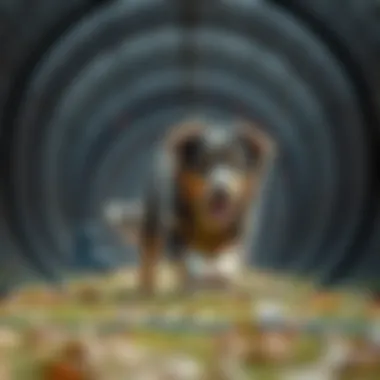
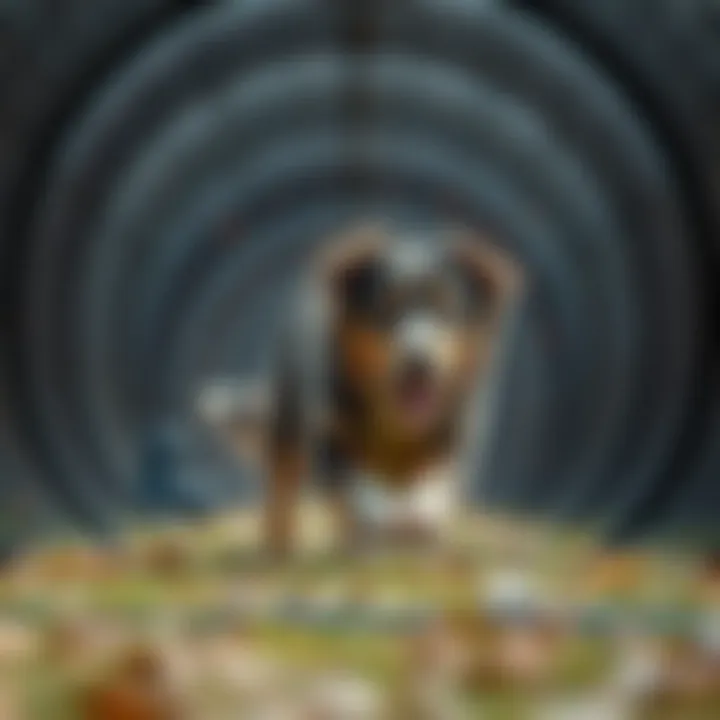
Whether they’re racing through tunnels or engaging in problem-solving, your dog benefits from the adventures brought by agility training. Consider making agility tunnels a part of your regular routine to reap these ample benefits.
Key Features of Agility Tunnels for Large Dogs
When it comes to selecting an agility tunnel for large dogs, understanding key characteristics is crucial. The right tunnel not only enhances a dog's training experience but also promotes safety and comfort. Let's delve into the important aspects that make for an effective agility tunnel suited to larger breeds.
Size and Dimensions
First and foremost, size is a primary concern for any agility tunnel tailored for larger dogs. Not all breeds fit the same mold, and finding the right dimensions can greatly impact your dog's willingness to navigate the tunnel successfully.
Generally, a tunnel meant for large dogs should have a diameter of approximately 24 inches or more. This allows breeds like Labrador Retrievers or German Shepherds to pass through comfortably without feeling confined. Length is also critical. A longer tunnel—around 10 to 12 feet—ensures your dog gets sufficient exposure to the challenge, building confidence and agility.
"Choosing the right size can mean the difference between a hesitant dog and one that sails through with joy."
Here are key points to weigh:
- Diameter: Ensure it's wide enough for your dog to maneuver without discomfort.
- Length: A more extended tunnel can offer a better training experience by creating a series of challenges.
- Fitting: Test your dog's fit in a store if possible; sometimes visuals can mislead.
Material Considerations
Another important aspect is the material from which the agility tunnels are constructed. Dogs can be quite adventurous, and their equipment should hold up against wear and tear. Most tunnels are made from either polyester or nylon, which offer durability along with lightweight characteristics.
Considerations include:
- Weather Resistance: If you plan to use the tunnel outdoors, choosing a water-resistant or UV-protected material is essential. This ensures longevity regardless of weather conditions.
- Flexibility: A well-designed tunnel will not only be durable but should also be flexible enough to withstand a large dog's speed and strength.
- Easy Setup: Lightweight materials can make setting up, taking down, and transporting your agility tunnel a breeze, perfect for those who are frequently on the move.
Stability and Safety Features
Even the best agility tunnel can become hazardous without proper stability and safety measures in place. A secure tunnel forms a safe environment that encourages dogs to explore and test their skills without fear of collapse or hazards.
Key features include:
- Anchoring Systems: Many agility tunnels come equipped with anchors or weighted ends to keep them securely in place, even during enthusiastic runs.
- Reinforced Structure: Double-stitched seams and reinforced edges can greatly enhance durability, making for a safer experience for your furry friend.
- Visual Appeal: Bright colors and patterns not only catch a dog’s eye but also guide them through the tunnel, promoting confidence in navigating obstacles.
Types of Agility Tunnels Available
When it comes to dog agility training, the type of tunnel you choose can make a significant difference in the experience for both you and your large dog. Understanding the various forms of agility tunnels can help you tailor your dog's training and playtime to their specific needs and preferences. Here’s a closer look at the popular options: standard tunnels, chute tunnels, and straight tunnels. Each serves its own purpose while providing unique benefits for your canine companion.
Standard Tunnels
Standard tunnels are the most commonly used in agility courses. They tend to be cylindrical, allowing dogs to dash through them with ease. One of the biggest draws to standard tunnels is their versatility. They can be set up for different training levels, accommodating beginners as well as advanced dogs. This adaptability makes them a favorite among agility trainers.
Some benefits to using standard tunnels include:
- Encouraging Speed and Confidence: Dogs often enjoy the thrill of racing through these tunnels, which helps build their speed and confidence.
- Ease of Setup: They are relatively easy to set up in various locations, whether it’s in your backyard or at a training facility.
- Enhanced Bonding Opportunities: Working through tunnels provides a great opportunity for bonding between owner and dog, as dogs often look back to the trainer for encouragement.
However, it’s important to keep an eye on the dog’s comfort. A tunnel that's too narrow might put them off, while a tunnel that's too wide may give them a feeling of instability. Whatever your choice, remember to observe your dog as they engage with the tunnel.
Chute and Straight Tunnels
Chute and straight tunnels offer an additional layer of complexity to agility training. While straight tunnels maintain a traditional shape much like the standard tunnel, they typically have a longer length. Chute tunnels introduce a different design element, often comprising a rigid opening that leads to a flexible fabric at the end. This design allows dogs to transition smoothly from a tunnel into an open space.
Benefits of these types of tunnels include:
- Varied Training Dynamics: The chute creates a scenario where dogs need to think about their next move as they exit, providing mental stimulation along with physical exercise.
- Building Perseverance: Chutes require dogs to push through a fabric barrier, which can enhance their persistence and determination.
- Preparation for Competitions: Many agility competitions include chute tunnels, so training with these can better prepare your large dog for what they’ll face in events.
It may take some time for your pooch to adjust to the new setup, especially with the chute. Positive reinforcement and a bit of patience go a long way in helping dogs feel comfortable with all types of agility tunnels.
Selecting the Right Tunnel for Large Dogs
Choosing the right agility tunnel for larger breeds is not just a matter of convenience, but one of safety and effectiveness. Big dogs have unique physical attributes and temperament traits that require careful consideration in order to ensure a positive experience during training.
When selecting a tunnel, size, stability, and material must all be taken into account. A poorly sized tunnel can hinder your dog's ability to maneuver comfortably, leading to frustration and potentially a lack of interest in training. Furthermore, it should be noted that larger dogs tend to have more power behind their movements, thus necessitating a structure that can withstand their force without tipping over or collapsing.
Assessing Your Dog's Size and Breed
Understanding your dog’s breed and size is crucial in making an informed decision. Different breeds vary not just in size but in their agility levels, energy, and instinctual behaviors. For example, a Golden Retriever may require a different tunnel compared to a Great Dane, simply due to the Great Dane’s larger girth.
When choosing a tunnel, measure your dog from nose to tail and consider their shoulder height as well. A tunnel that is too short might lead your dog to feel cramped and distrustful of their ability to fit through it. Conversely, if a tunnel is too wide, it may not effectively encourage your dog to engage as it should. Therefore, pick one that corresponds closely with their dimensions, ensuring an optimal fit.
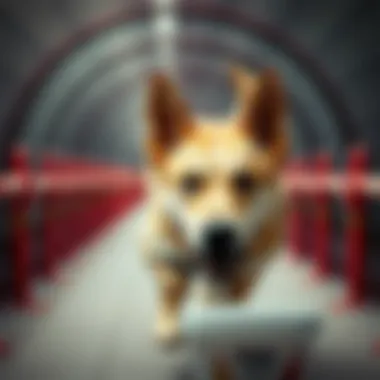
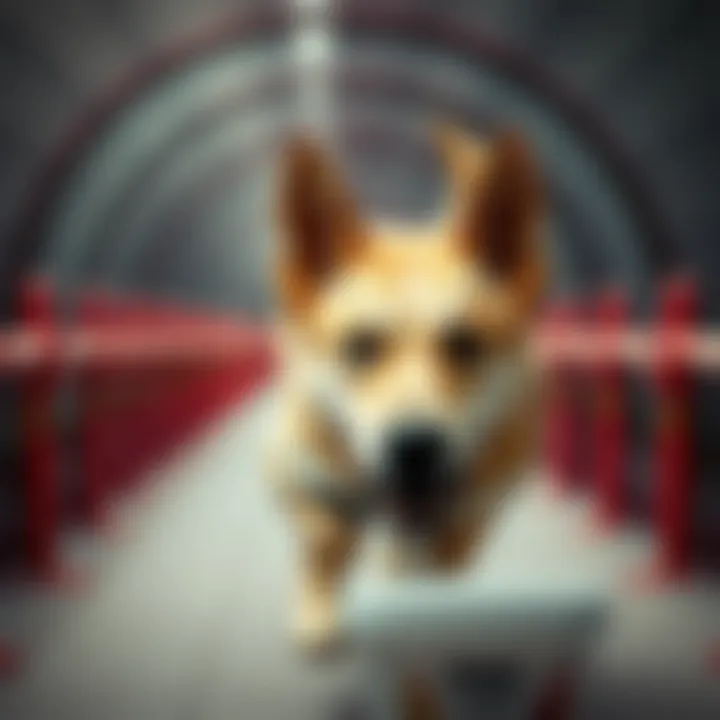
Evaluating Your Training Goals
Your training objectives will play a sizable role in determining which tunnel is best suited for your canine companion. Are you looking to boost your dog's speed, improve their focus, or maybe build up their confidence? Depending on your goals, certain tunnel types may better facilitate these ambitions.
For instance, if you wish to enhance your dog’s speed, a straight tunnel may serve better, as it enables quick entries and exits, honing in on their racing instincts. On the other hand, if developing a sense of confidence is your aim, a wider chute can provide a comforting space allowing your dog to explore without feeling confined.
Budget Considerations
When it comes to selecting an agility tunnel, budget is an important factor. You may find options on the lower end that are cheaper, but they might not be ideal for larger breeds. Low-quality materials can lead to quick wear or even dangerous situations during use. Investing a bit more can go a long way in ensuring safety and durability.
Consider what fits within your financial constraints, but also evaluate the benefits you would gain from spending a little extra to obtain a well-constructed product. High-quality tunnels not only last longer but usually come equipped with features that enhance safety and performance.
In summary, choosing the right agility tunnel for large dogs encompasses a mix of understanding your dog’s needs, clearly defining your training objectives, and making savvy financial choices. Assess each aspect carefully to pave the way for an enriching and enjoyable experience for both you and your furry friend.
Setting Up the Agility Tunnel
Setting up an agility tunnel is more than just a chore—it's a crucial step in ensuring your dog's training is effective and enjoyable. A well-placed and properly set-up tunnel can transform a dull training session into a stimulating challenge for your furry friend. This section examines the key elements involved in setting up the agility tunnel, focusing on two vital aspects: choosing the right location and preparing the training area.
Choosing the Right Location
Finding the right spot for the agility tunnel is like choosing the best seat in a concert hall; it can make all the difference. You want an area that allows your dog to navigate the tunnel without distractions or hazards.
- Space Considerations: Make sure you have enough room for the tunnel's length and width, as well as a bit of extra space on either side for safety. Ideally, a flat, even surface, free from obstructions, is best. This allows your large dog to run comfortably without tripping over anything.
- Visibility: Place the tunnel in an open, well-lit area to ensure your dog can see its surroundings while training. A bright, inviting atmosphere encourages your pup to engage more fully in the agility experience.
- Surface Type: Opt for grass, dirt, or a synthetic training mat that provides both grip and cushioning. Avoid slippery surfaces like concrete, as they can pose a danger, especially when your dog is speeding through the tunnel.
"A suitable location can turn training from a task into a rewarding play session."
Preparing the Training Area
Once you've pinpointed the perfect location, it's time to get the training area ready. This is where the magic happens.
- Clearing the Space: Before setting up the tunnel, make sure to remove any obstacles, such as toys, debris, or gardening supplies that could impede your dog's run. A clutter-free environment fosters concentration and safety.
- Setting Up the Tunnel: When you assemble the tunnel, adhere to the manufacturer's guidelines. Ensure that the structure is sturdy and securely fastened to the ground if necessary, to prevent it from collapsing while your dog charges through.
- Marking Boundaries: Establish clear boundaries for your training area. Consider using cones or other markers to denote the start and end points of the tunnel. This provides your dog with visual cues and reinforces a defined training path.
- Environment Control: If possible, train when it's not too windy or rainy, as these elements can create distractions for your dog. Training on calmer days enhances focus and allows for a smoother experience.
Ultimately, setting up the agility tunnel involves careful consideration of location and preparation. By taking these thoughtful steps, you provide a solid foundation for a successful training journey with your large dog.
Training Techniques for Large Dogs
Training techniques for large dogs play a crucial role in ensuring that not only do these dogs master agility tunnel skills, but they also enjoy the training process. Large breeds, such as German Shepherds or Golden Retrievers, have unique physical and mental needs. Addressing these needs through appropriate training techniques helps maximize their potential while keeping safety at the forefront. Without well-informed training approaches, you may face challenges like lack of motivation or even injuries, and nobody wants to go down that road.
Prologue to Agility Training
Agility training is more than just a series of jumps and weaves; it's about establishing a communication bridge between you and your dog. When you introduce agility tunnels into the mix, you elevate that bond even further. For large dogs, their size may sometimes be intimidating, so it's vital to approach agility training with a solid foundation of trust and encouragement.
First off, familiarize your dog with the equipment. Let them observe the agility tunnel from a distance before attempting any run-throughs. You can take playful cues from their behavior, clapping or offering treats as they sniff around the tunnel. This phase is less about getting through the tunnel and more about creating a comfortable mental space so your dog associates the equipment with fun.
Additionally, starting with basic commands lays a good groundwork. For example, teaching commands like "come" or "wait" early on helps them understand what you expect from them when they enter the tunnel. Patience and repetition in a positive atmosphere can work wonders.
Step-by-Step Training Approaches
Once your dog is comfortable with the tunnel, you can jump into the nitty-gritty of training using a systematic approach. Here’s a step-by-step guide to get you started:
- Familiarization Phase
- Getting Comfortable
- Introducing Speed
- Adding Complexity
- Regular Practice and Patience
- Let your dog explore the tunnel without pressure. Use treats to entice them to go inside, even if just for a few seconds.
- Gradually start to reward your dog as they enter, even if they only put their head inside.
- Once they’re used to the structure, increase their duration inside the tunnel. Sit at the other end and call your dog using the "come" command.
- Celebrate their success, no matter how small. A wag of the tail is a sign of progress!
- After they can confidently navigate through the tunnel slowly, encourage speed. Toss a favorite toy or lure them with treats at the end of the tunnel.
- Be sure to keep the mood light. If they hesitate, backtrack to the previous phase and reinforce their confidence.
- Once your dog is running through quickly, consider incorporating additional obstacles if they're ready for it, such as jumps or scooting around barrels to enhance both their focus and agility.
- Mixing it up keeps the training fresh and exciting for your dog, reinforcing their interest in agility.
- Consistency is key. Try to set aside time for agility training several times a week. Regular practice helps reinforce behaviors and prevents regression.
Training your large dog in agility is not just about physical fitness; it’s also a marvelous way to bond and communicate with them.
Every dog is different, and some might pick things up faster than others. Tailor your training to your dog’s pace and remember that this journey is as much about building confidence as it is about acquiring skills. After all, each tail wag signifies a tiny victory in your training sessions.
Safety Considerations During Training
When it comes to dog agility training, safety isn't just a checkbox to tick off; it’s the gold standard. Focusing on safety ensures that large dogs can enjoy the agility tunnels without the risk of injury or stress. Obsessing over safety can transform a potentially risky training exercise into a rewarding experience for both the dog and the owner. This segment emphasizes the importance of supervision and recognizing the limitations of your dog, creating a secure and supportive training environment.
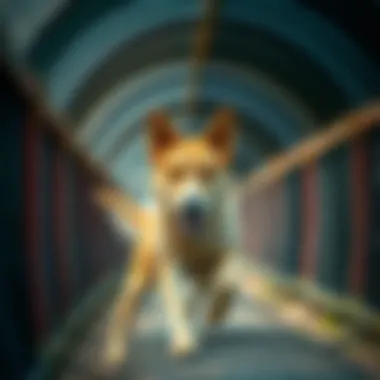
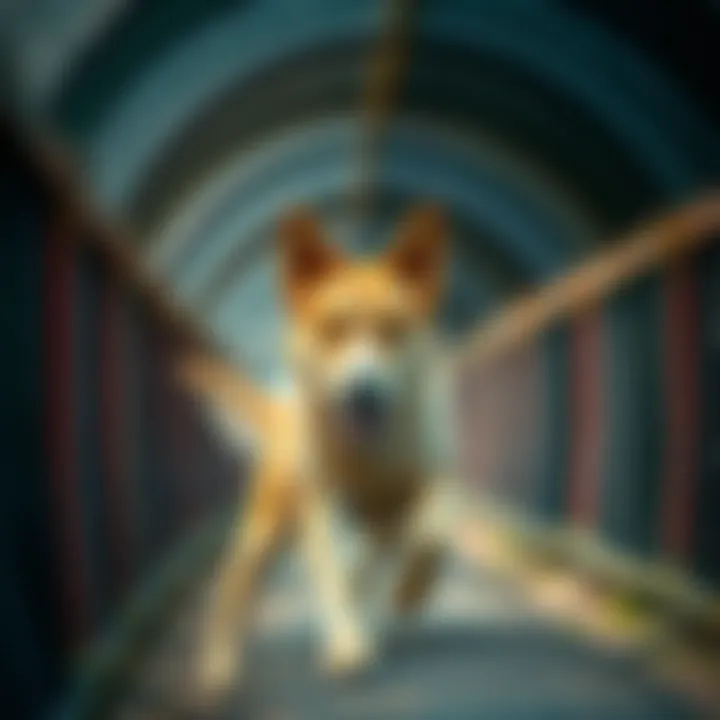
Supervising Your Dog
It's essential to keep a watchful eye on your large dog during agility training. Monitoring helps prevent accidents and allows for timely interventions when needed. Here are critical points to consider:
- Constant Supervision: Never leave your dog unsupervised near the agility tunnel. This way, you can take quick action if things don’t go as planned.
- Positive Reinforcement: Offering encouragement while supervising will boost your dog's confidence. Rather than just correcting mistakes, celebrate the successful runs.
- Observe Body Language: Dogs communicate a lot through their body language. If your dog shows signs of anxiety, such as excessive panting or cowering, it may be time for a break or to adjust the training approach.
“Understanding your dog's behavior is key. A happy dog is a trained dog, and supervision plays a significant role in their happiness.”
In addition to these points, keep close tabs on their physical condition. Large dogs can overexert themselves easily, which could lead to injuries. Look for any signs of tiring; this could mean slowing down or even stopping the session altogether.
Recognizing Limitations
For large dogs, it’s vital to recognize their physical and emotional limitations. Pushing them beyond what they can handle can lead to physical injuries or stress. Consider these aspects:
- Age and Health: Older dogs or those with health issues may not be able to handle as rigorous training as younger, healthy dogs.
- Skill Level: Just as humans have different skill levels, so do dogs. Some may need more time to learn the basics before tackling more complex skills.
- Environment: Elements such as slippery surfaces or harsh weather can hinder a dog’s performance and affect their safety.
By understanding these limitations, you can tailor the training to be more effective and safer. Create a realistic training plan considering your dog's unique capabilities and adjust the difficulty gradually.
In summary, safety considerations during agility training for large dogs can't be an afterthought. By prioritizing supervision and recognizing limitations, you'll foster an enriching experience that enhances both the physical and mental well-being of your furry companion. For more advanced safety strategies, consider resources like The American Kennel Club or visit related forums on Reddit.
Maintaining Your Agility Tunnel
Keeping your agility tunnel in tip-top shape is crucial not just for the longevity of the equipment, but also for the safety and performance of your large dog. Ensuring regular care and maintenance prevents accidents and enhances the training experience. Just like you wouldn’t drive a rusty old car without checking the brakes, your agility tunnel deserves the same kind of attention. Here’s what you need to consider to keep it in prime condition for those spirited runs.
Routine Inspections
Conducting regular inspections helps catch potential issues before they snowball into bigger problems. It’s best to set a schedule, perhaps once every couple of weeks or after particularly heavy use. During these inspections, keep an eye out for:
- Tears or Punctures: Even the most durable materials can succumb to wear and tear over time. Small rips can quickly grow larger and pose a risk to your dog.
- Stability: Make sure the tunnel remains secure and doesn’t shift or move while your dog runs through it. Check the ground around the tunnel for loose dirt or debris that might affect stability.
- Cleanliness: Though it may sound obvious, grime can build up quickly, especially if you use your tunnel outdoors. Look for any signs of dirt accumulation that could detract from the agility experience.
Cleaning and Storage Tips
Cleaning your agility tunnel prolongs its life and keeps it looking fresh. After each use, dust off any visible dirt or mud. However, a deeper clean is needed periodically. Here’s a simple guide to ensure your tunnel is spick and span:
- Use Mild Soap and Water: Mix a little soap with warm water, and make sure to rinse well. A soft brush can help reach those stubborn spots where dirt likes to hide.
- Dry Thoroughly: Allow your tunnel to dry completely before folding or storing it. Moisture can lead to mold or develop odors that might deter your dog from re-entering it.
- Store Properly: Between uses, store the tunnel in a cool, dry place away from direct sunlight. It’s best if it’s folded neatly to maintain its form.
"A stitch in time saves nine"—that saying rings true for equipment maintenance. A little ounce of prevention goes a long way in preserving your dog's agility tunnel.
By taking the time to maintain your agility tunnel, you not only enhance your dog's training experience but also extend the lifespan of the equipment, ensuring endless hours of fun and activity. Remember, a well-cared-for tunnel means a happier dog, eager to tackle whatever comes their way!
Engaging with the Dog Agility Community
Engaging with the dog agility community is not just about flaunting your skills with your large dog in a tunnel; it’s about building connections, sharing experiences, and growing together with fellow enthusiasts. This camaraderie can greatly enrich your training experience, enhancing not just individual goals but also collective progress in the sport.
Joining Clubs and Forums
Becoming a member of clubs or forums dedicated to dog agility opens the door to a plethora of resources and networking opportunities. These platforms host discussions ranging from beginner tips to advanced techniques—there’s something for everyone. Here are some reasons why joining these groups can be beneficial:
- Shared Knowledge: You tap into the wisdom of others who have walked the same path. This can save you from costly mistakes.
- Motivation: Being around like-minded individuals often lights a fire under one’s commitment. You zip through training challenges just by being part of a team.
- Exclusive Events: Membership in clubs often leads to invitations for seminars, workshops, and special training sessions that aren’t available to the general public.
- Support System: You’ll find emotional support when the going gets tough, plus the practical tips that can help turn around a tricky training situation.
While the internet can be a treasure trove of information, there's a certain je ne sais quoi about face-to-face interactions that enriches the learning environment. Local clubs provide that human touch, a sense of belonging that can boost your enthusiasm.
Attending Local Competitions
Participating in local competitions is another excellent way to immerse yourself in the agility scene. These events aren’t merely about winning; they are opportunities to learn, showcase your dog’s talents, and see how you measure up against others in your area. Here are a few points to consider:
- Real-World Experience: Competing provides a chance to put your training into practice under competitive conditions, which differs from home training. It might seem daunting at first, but it’s a great learning experience.
- Benchmarking Progress: Competitions offer a tangible way to gauge your dog’s agility skills. You can see where improvements are needed and determine what training focus is next.
- Networking Opportunities: These events attract a variety of participants, from newcomers to seasoned pros. You’ll likely meet trainers willing to share their insights.
- Fun and Excitement: The thrill of competition can be invigorating for both dog and handler. Rousing encouragement from spectators adds an electrifying atmosphere.
Engaging actively within the dog agility community, whether through clubs or competitions, fuels passion and dedication not seen when you tackle training alone. Connecting with others can transform this enriching experience into one that propels both you and your large dog towards greater heights.
Finale
In wrapping up our discussion on the significance of dog agility tunnels designed for large breeds, it is crucial to reflect on several essential aspects. The advantages of incorporating agility training into a dog’s routine extend far beyond mere recreation; it offers profound benefits that cater to both the physical and mental needs of your canine companion.
Reflections on the Importance of Agility Training
Engaging in agility training is an excellent way for large dogs to channel their energy into something constructive. This discipline not only provides physical exercise, helping to maintain a healthy weight and reducing the risk of health issues like obesity or joint problems, but it also fosters mental stimulation. The challenges that come with navigating tunnels, overcoming obstacles, and mastering commands strengthen the bond between dog and trainer while enhancing problem-solving skills.
Moreover, the communal aspect of agility training is often overlooked. As you immerse yourself in this sport, you may find a tight-knit community of enthusiasts who share insights, training tips, and encouragement. Participating in local events or clubs helps foster camaraderie and can motivate both you and your dog to achieve new heights.
Training sessions can serve as a platform for dogs to practice socialization, reducing anxiety and promoting confidence, especially in large breeds that may be prone to fearfulness in new situations. By understanding your dog's strengths and limits during these exercises, you cultivate a nurturing environment that values their unique capabilities. Thus, agility training is not just about speed and skill; it's about building trust and creating joyful experiences between you and your dog.
Reflecting on all these points, it is evident that agility training is an invaluable tool that may enrich the lives of large dogs and their owners alike. The investment of time and resources into agility tunnels and training fosters a more active lifestyle, strengthens the human-animal bond, and ultimately results in a more content and well-adjusted canine friend.
"Agility training transforms not just the dog but the relationship it has with its owner, creating a partnership of trust and joy."







